Introduction
The dynamics of land acquisition for energy projects are evolving rapidly, reflecting the broader changes occurring in the energy sector. With billions of dollars being invested in renewable resources and grid development, land acquisition specialists play a crucial role in integrating project economics, technical requirements, and stakeholder engagement. The North American energy market anticipates a staggering $12 trillion investment in renewables by 2050, highlighting the shift towards sustainable energy sources like wind, solar, and green hydrogen.
Land acquisition specialists go beyond identifying and negotiating for land parcels; they also optimize land use and revenue streams by outlining terms for dual-use and agricultural activities. The expertise of these specialists is pivotal in navigating complex transactions and ensuring deals align with evolving market demands and stakeholder concerns. Moreover, as the demand for renewable energy sources increases, the need for transmission lines rises, further emphasizing the importance of a robust acquisition strategy.
Specialists must adeptly manage risks while adhering to legal, regulatory, and environmental frameworks. The changing landscape of the energy sector requires land acquisition professionals to be forward-thinking and adaptable to the evolving demands of the industry and community stakeholders.
Understanding the Role of Land Acquisition Specialists
The dynamics of obtaining property for power initiatives are developing swiftly, mirroring the wider transformations happening in the power industry. As billions are invested in renewable resources and grid development, experts in procuring real estate must incorporate a deep comprehension of project economics, technical requirements, and stakeholder engagement into their roles. The North American power market alone expects a staggering $12 trillion investment in renewables by 2050, indicative of the shift towards sustainable power sources like wind, solar, and green hydrogen.
The function of land procurement experts in power initiatives goes beyond merely identifying and bargaining for parcels. With the typical duration of solar leases ranging from twenty to thirty years, they are also responsible for defining conditions that may enable the area to be used for multiple purposes, such as farming activities, to maximize land utilization and income sources. The adoption of automation in industries has led to a significant rise in power demand, which further underscores the importance of strategic site selection and understanding a client's power requirements.
In the context of large-scale renewable power initiatives like the Nysäter wind farm in Sweden, which powers over 300,000 households, land procurement experts are crucial in navigating intricate transactions and ensuring deals align with the evolving market demands. Their proficiency in managing the complexities of such transactions, including stakeholder interests and environmental factors, is vital for the smooth advancement of projects.
The heightened demand for sustainable power sources has also raised the necessity for transmission lines, intensifying the risk of conflicts and escalating the significance of a strong procurement strategy. Experts must be skilled in handling these dangers while following the lawful, regulatory, and environmental structures that control the procurement of property. The evolving scenery of the power sector, with its emphasis on reducing ecological footprints and embracing sustainability, necessitates land professionals to be forward-thinking and adaptable to the progressing demands of the industry and community stakeholders.

Key Steps in Land Acquisition Process
Obtaining land for energy initiatives is a complex procedure that involves a sequence of crucial stages, each demanding careful consideration to guarantee smooth progress. Initially, the process demands a thorough project planning stage, incorporating clear goal definition to guide the entire acquisition. Budgeting is another essential component, taking into account both the direct costs of purchasing the property and the ancillary expenses associated with compliance and due diligence.
Navigating zoning laws and regulatory compliance is often a complex endeavor, as highlighted by the challenges posed by the National Environmental Policy Act (NEPA) and similar state laws which can introduce significant delays and elevated costs. It's essential to carry out thorough surveys and environmental assessments to meet these legal requirements and to inform the negotiation process.
When it comes to the negotiation and purchase phase, due diligence and title review are essential to confirm the suitability of the property and to preempt future disputes. This was demonstrated in a case in the Chiba Prefecture, where a client sought to purchase Akiya land, highlighting the significance of comprehending the complete extent of the undertaking, including costs and procedural requirements.
The completion of the purchase and the transfer of ownership mark the culmination of the procurement phase, but it's the post-purchase planning and infrastructure development that truly realize the project's potential. Infrastructure investments sometimes necessitate compulsory acquisition to prevent a minority of owners from impeding progress, a testament to the delicate balance between private property rights and the public interest.
As the demand for sustainable power rises, as indicated by Dunbar, the requirement for appropriate locations for power generation becomes more and more crucial. This demand influences site selection and the requisite power infrastructure to support automation and the growing power needs of modern technology. The partnership with Indigenous Communities, like the cooperation with the McLeod Lake Indian Band on a hydrogen initiative, highlights the importance of harmonizing sustainable development with cultural and environmental responsibility.
To sum up, the process of obtaining property for power ventures is a complex voyage, starting from the initial planning phase to the development that follows. Each step is interwoven with legal, financial, and environmental considerations that must be navigated with expertise and foresight.
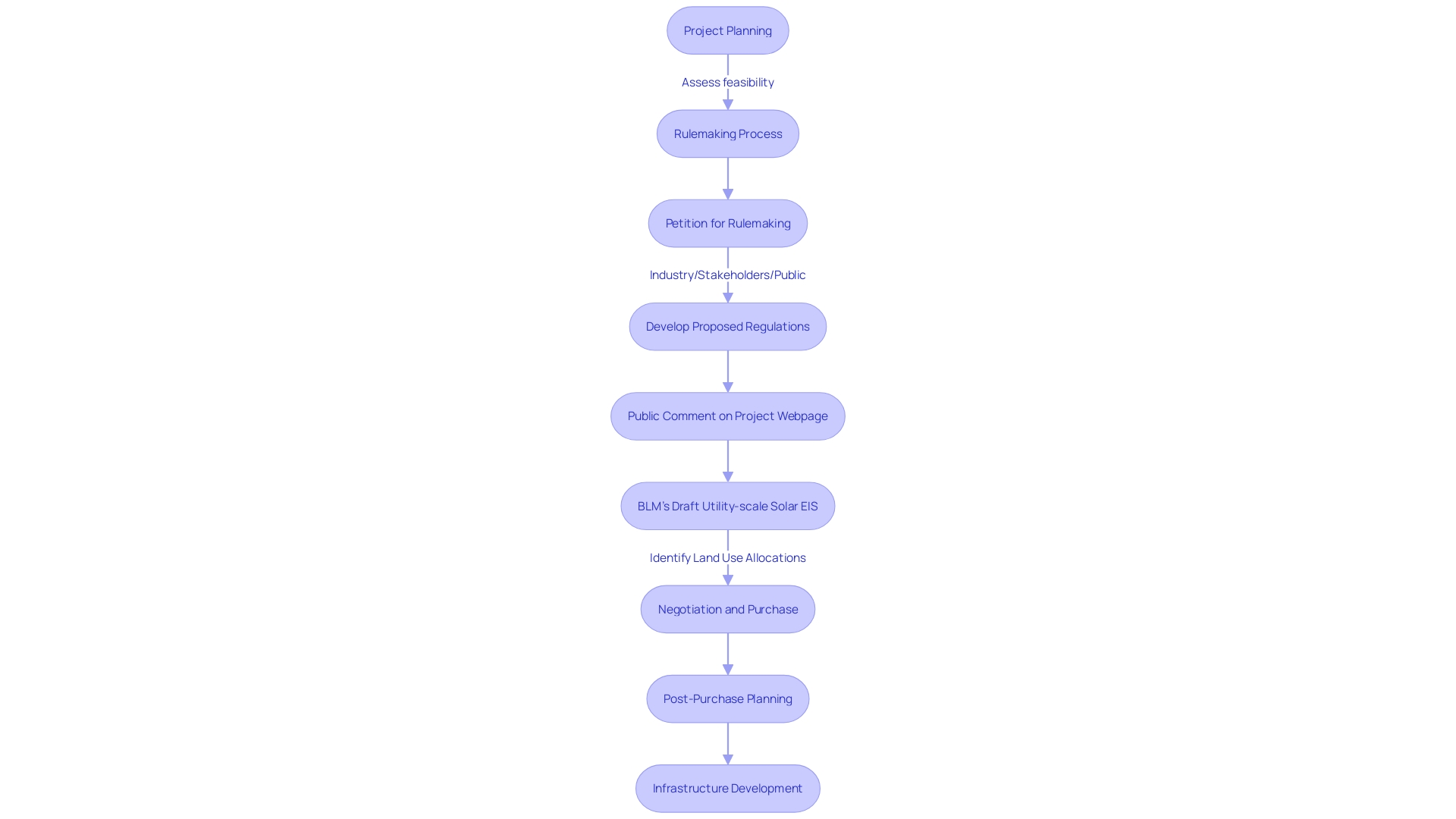
Project Planning and Goal Definition
A careful method of planning is crucial for the successful acquisition of land for power initiatives. It commences with a thorough comprehension of the distinct needs of the power sector and the specific venture related to the utilization of resources. Whether aiming to utilize wind or solar power, initiatives must be customized to the local circumstances, taking into account technical, economic, and legal factors. Every endeavor necessitates a customized site assessment to determine the feasibility of the area and to pinpoint any possible hurdles that may occur, such as ecological restrictions or public apprehensions.
Renewable initiatives, specifically, are ready to have a crucial part in the worldwide shift to sustainable power. As mentioned in a thorough report by the international organization Sustainable Energy for All, the creation of communities focused on sustainable power and the installation of renewable power systems are crucial for attaining Sustainable Development Goal 7. The report delves into the economic, technical, and legal intricacies specific to renewable power projects, offering valuable insights that can steer the land acquisition process.
Moreover, the increasing demand for sustainable power as a result of the widespread implementation of automation and the related rise in electricity demands calls for an evaluation of not only the current requirements but also the expected future advancements. This is highlighted by the findings from the General Authority for Statistics, which reflect the dynamics of power usage and population growth that can impact site selection.
The National Environmental Policy Act (NEPA) and similar state laws, though essential for safeguarding the environment, can introduce significant delays and compliance costs into the development process. This underscores the importance of early and thorough planning to navigate the legal landscape effectively. A Justice40 Initiative plan, which encompasses diversity, equity, inclusion, and accessibility objectives, can be instrumental in ensuring that disadvantaged communities benefit from power initiatives, further emphasizing the necessity of a comprehensive and strategic approach to property procurement.
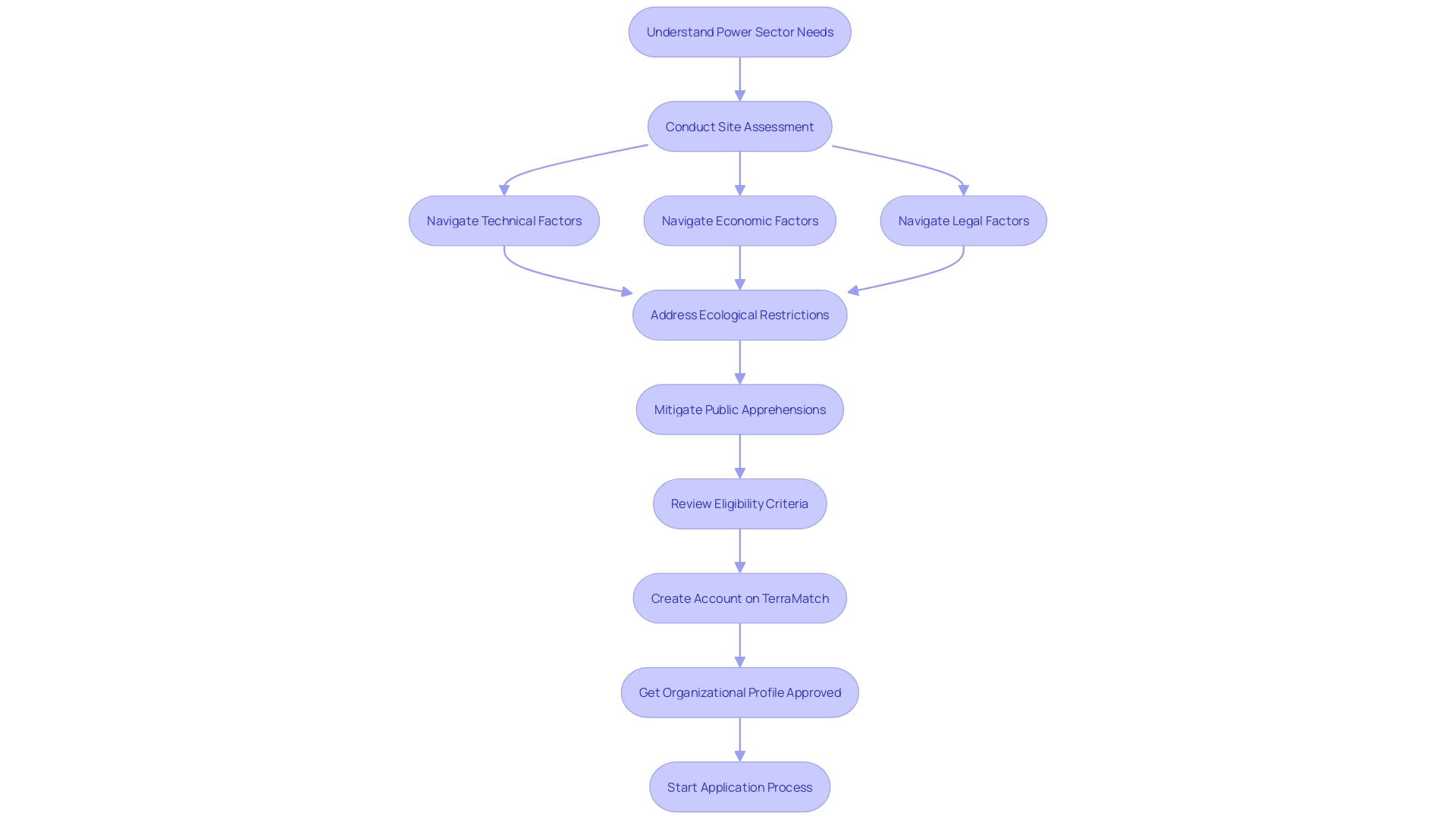
Budgeting for Land Acquisition
Allocating sufficient funds for land procurement is a crucial element of any energy endeavor. This financial planning phase encompasses a spectrum of expenses, such as the property's purchase cost, legal fees, and expenses for necessary surveys and environmental assessments. A comprehensive budgeting strategy guarantees that projects are sufficiently funded, avoiding unexpected costs that can jeopardize project timelines and financial stability.
For example, in a case study of an Akiya property purchase in the Chiba Prefecture, the initial engagement fee was ¥220,000. This example underscores the importance of transparency and detailed cost breakdowns for clients understanding the full scope of the investment. Additionally, regulatory frameworks like the National Environmental Policy Act (NEPA) can introduce significant delays and compliance costs into development timelines, emphasizing the need for meticulous budgeting.
In the present environment characterized by growing demand for sustainable power, the financial planning for property procurement must also consider the possibility of higher power needs as a result of automation and technological progress. This shift necessitates a forward-looking approach to site selection and infrastructure investment, acknowledging that automated processes may lead to a substantial increase in power demand.
Furthermore, public grounds and structures, which are frequently underutilized, represent valuable assets that can be leveraged for infrastructure investments. By investing in improved access to these resources, there is substantial potential to support the development of projects. This strategic approach to asset utilization can help address the challenge of land scarcity and streamline the acquisition process.
Demonstrating the wider industry patterns, the UK government's choice to allocate a historic £1.5 billion for new sustainable power generation is evidence of the sector's expansion and the necessity of transitioning to a greener power grid. Such governmental support serves as an encouraging signal to the industry, enabling faster initiation of initiatives that could otherwise take years to develop.
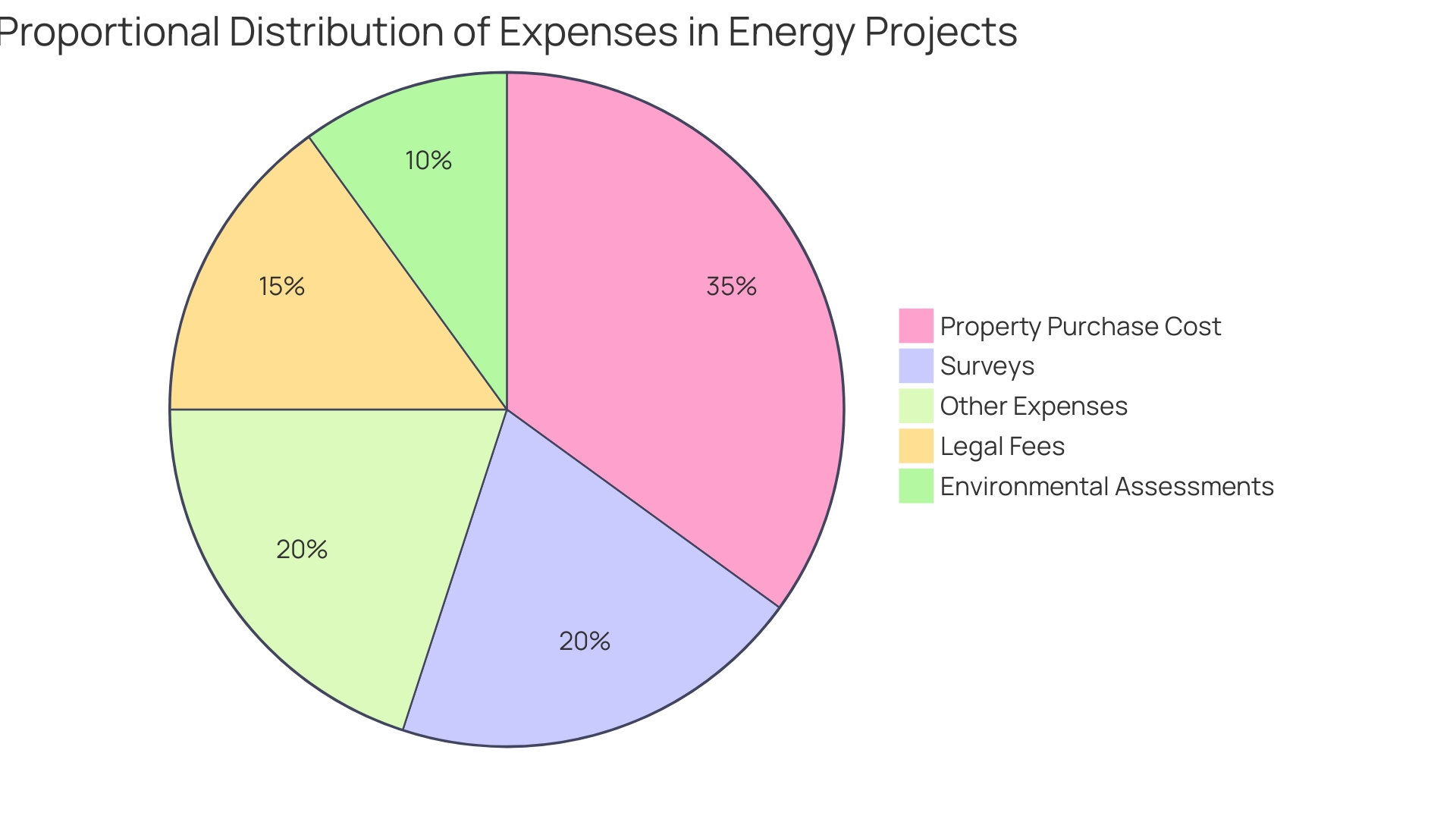
Zoning and Regulatory Compliance
Managing the acquisition of land for initiatives involves a complex and diverse set of challenges related to zoning and regulatory compliance. It necessitates a thorough understanding of zoning laws that vary by locality and ensuring adherence to a broad spectrum of regulations at the municipal, state, and federal levels. This process typically includes securing necessary permits, conducting comprehensive environmental impact assessments, and proactively engaging with regulatory bodies and community stakeholders to mitigate any concerns.
Key legislation such as the National Environmental Policy Act (NEPA) and the California Environmental Quality Act (CEQA) has historically aimed to foster transparency in environmental impact. However, these laws have evolved in their application, often resulting in significant project delays—ranging from 2 to 6 years—as well as escalating compliance costs. These impediments can be attributed to various factors, including resistance from local groups and the complexities of the legal frameworks themselves.
The significance of this regulatory navigation is emphasized by organizations like the Clean Air Task Force (CATF), which stress the urgency of deploying low-carbon solutions to mitigate climate change. CATF's advocacy for practical policy approaches reflects the balance needed between environmental protection and the facilitation of necessary infrastructure.
Recent developments highlight the conflict between expansion in the power sector and regulatory compliance. For instance, Duke Energy's proposal to construct two large gas-fired power plants in North Carolina, capable of generating 1,360 megawatts each, has encountered public scrutiny. Studies linking proximity to natural gas wells with health concerns further complicate the narrative, suggesting that current setbacks may not sufficiently safeguard public health.
Legal challenges also play a role, as seen in the City of Chicago's lawsuit against major oil and gas companies for allegedly deceiving the public regarding the environmental impacts of fossil fuels. The legal case emphasizes the wider framework in which power initiatives should take into account the possibility of legal action and public perception consequences.
In the midst of these intricacies, it is evident that the effective location and authorization of power initiatives necessitate a tactical method that navigates the complex network of regulations, involves with interested parties, and stays attentive to evolving legal and societal standards.
Conducting Land Surveys and Environmental Assessments
Before concluding any acquisition for energy initiatives, it is crucial to conduct thorough surveys in conjunction with extensive environmental evaluations. These crucial steps are essential in identifying possible environmental consequences or constraints related to the area in question. Surveying the terrain is crucial for obtaining accurate measurements and boundary information, which is vital to guarantee that the property meets the particular requirements.
Nevertheless, it is crucial to recognize that the acquisition of property, especially for projects related to power generation, is not devoid of its intricacies. Regulatory frameworks such as the National Environmental Policy Act (NEPA) and the California Environmental Quality Act (CEQA) can significantly extend the timeline and elevate costs. These laws, designed to ensure environmental impact disclosure, have increasingly become tools for opposition groups to introduce delays of several years and drive compliance expenses to staggering heights.
For instance, the research conducted on Ohio's fracking boom revealed the intricate challenges faced when dealing with landowners. The study highlighted cases where landowners were persistently approached for lease agreements, reflecting the sometimes aggressive tactics that can be involved in securing land access.
Moreover, the development of offshore renewable energy, as observed in the Belgian North Sea, has demonstrated long-term impacts on marine ecosystems. This aspect underlines the importance of a thorough environmental review to understand and mitigate potential adverse effects on local flora and fauna.
Furthermore, legal disputes often arise due to subjective interpretations of environmental impact, leading to additional studies and further delays. This underscores the necessity for detailed initial assessments to anticipate and address potential legal challenges.
Investments in infrastructure often require compulsory confiscation to bypass obstacles caused by a minority of owners. This process can be lengthy and may involve disputes over titles or compensation, which highlights the importance of thorough preparation and negotiation in the procurement phase.
In light of the increasing demand for renewable energy and the consequent need for new transmission lines, the likelihood of disputes has escalated. In this ever-changing market, it is essential to adopt a cautious strategy when obtaining property, while considering both development requirements and environmental factors, in order to guarantee the feasibility and adherence to regulatory standards.
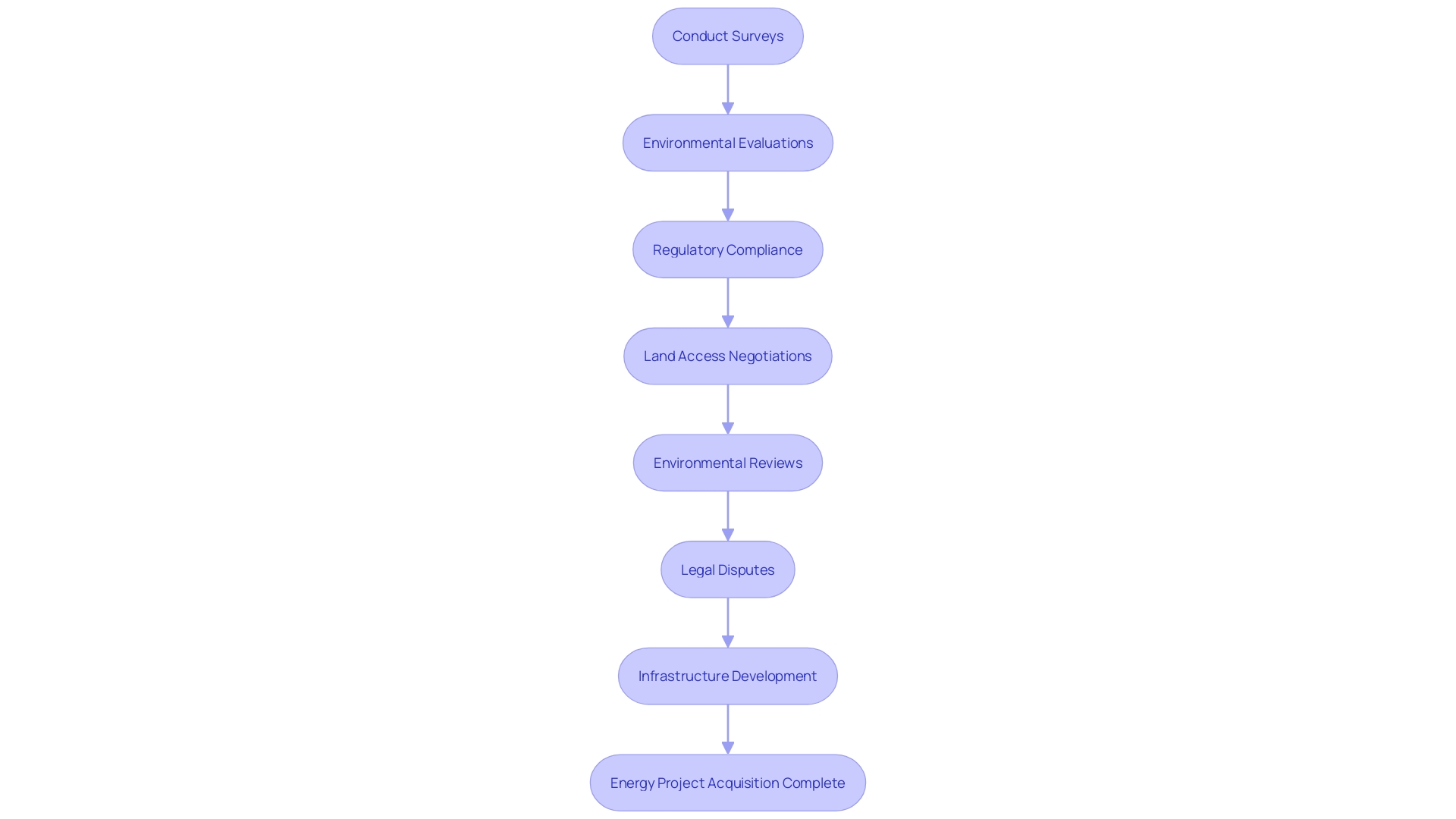
Negotiation and Purchase of Land
Utilizing skilled bargaining methods to complete property deals represents a crucial element of the procurement plan. Specialists in this field engage directly with property owners, employing a blend of finesse and strategic insight to achieve mutually beneficial outcomes. This intricate dance often includes assessing the property's fair market value, finessing the purchase price, and diplomatically addressing any landowner stipulations or concerns. The successful culmination of these discussions leads to the formalization of the transaction through legal contracts.
A quintessential example of the nuanced negotiation process can be observed in the Akiya market transactions, where buyers look to secure properties that offer a retreat from urban centers, such as the idyllic locales near Chiba Prefecture's sandy shores. The transaction, often initiated with a modest engagement fee, unfolds as a tailored journey to locate the perfect countryside property for the client. Similarly, in the broader context of resource and power development, such as the anticipated redevelopment of Kuala Lumpur Sentral Station, the negotiation process takes center stage, underpinning significant infrastructure investments and shaping future urban landscapes.
The successful negotiation and acquisition of land for sustainable power projects, in particular, are essential in meeting the ambitious goals set by international organizations, such as Sustainable Energy for All. These endeavors align with the overarching aim to facilitate universal access to sustainable power and contribute to the global effort to mitigate climate change.
In the context of renewable installations, the negotiation process extends beyond mere financial transactions, encompassing a comprehensive understanding of the economic, technical, and legal intricacies involved. This comprehensive understanding is crucial in promoting communities and driving the expansion of solar and wind project installations across various geographies, from Valencia to Heerlen.
Statistical analyses strengthen the importance of land negotiations within the resources and power sectors. Reports highlight an uptick in investment within the mining and energy landscapes, suggesting a dynamic and evolving market ripe for strategic acquisitions. Furthermore, the infusion of capital through various financing activities, including venture capital and large-scale project funding, underscores the vibrancy and potential of these sectors.
As industry experts like Shauna Gamble of Bombardier emphasize, the essence of negotiation is rooted in a profound understanding of the stakeholders' motivations and aligning them with strategic goals to arrive at a win-win scenario. In this intricate terrain, where every plot carries its distinctive potential and purpose, the capability to navigate negotiations with data-driven insights and a keen understanding of market dynamics is invaluable. This approach not only ensures the closure of equitable deals but also fosters long-term, sustainable development that resonates with the evolving demands of the power and infrastructure sectors.
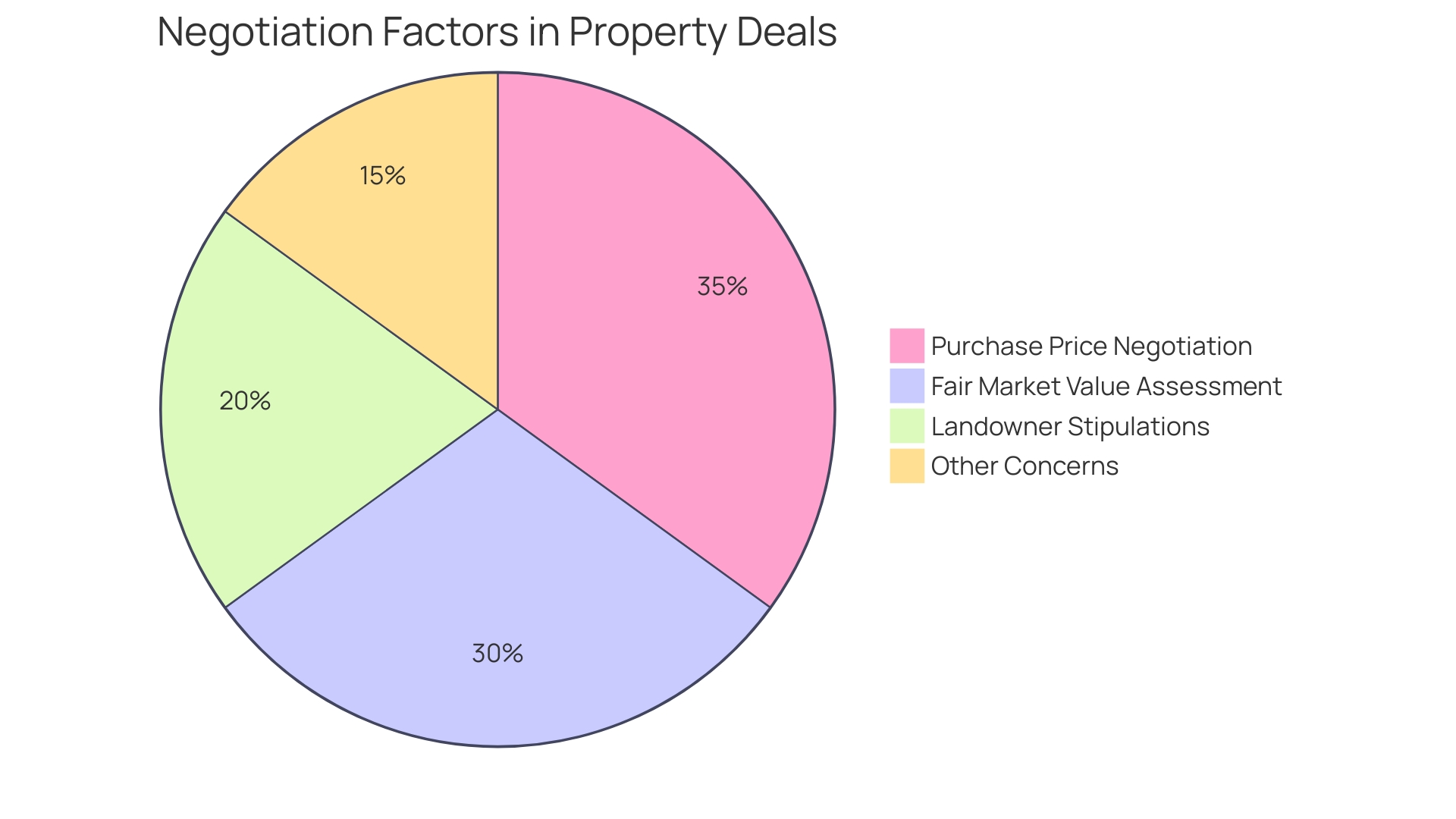
Due Diligence and Title Review
The multifaceted process of due diligence and title review is a cornerstone in securing property for energy projects. It involves a meticulous examination of the historical title records, ensuring the legitimacy of ownership, and uncovering any potential encumbrances or legal disputes that could impact the transaction. Experts in procuring property work closely with legal experts to minimize any title-related problems, enabling a smooth transfer of property rights.
Land acquisition for energy projects often reveals complex scenarios, as illustrated by a case in Chiba Prefecture, where a buyer sought to purchase a property near the beach. The process required an initial investment to commence the search, highlighting the financial and procedural commitments involved. In another instance, litigation arose from a dispute over the fair market value of expropriated property, showcasing the legal intricacies and potential for disagreement in determining property value.
Historical cases provide further context to the importance of thorough due diligence. For instance, in Manhattan Beach, California, the city government's acquisition of property through eminent domain in the 1920s highlights the lasting consequences and sensitivity surrounding ownership and utilization of the area. These instances highlight the need for thorough title examination to avoid future legal disputes and guarantee unambiguous ownership for power initiatives.
In the high-speed domain of power development, the requirement for clear property titles is crucial, as demonstrated by the inquiry of the Alberta Utilities Commission into the development of electricity generation. The commission's initiative reflects the industry's focus on securing territory that is free from disputes, ensuring that infrastructure plans can advance without unexpected obstacles.
Supporting this need, industry leaders like First American Financial Corporation demonstrate the significance of robust title services, having built a legacy over 130 years with a revenue of $7.6 billion in 2022, indicating the scale and importance of title insurance in real estate transactions. Similarly, organizations such as the American Land Title Association (ALTA) and Title Insurance Political Action Committee (TIPAC) are instrumental in representing the title industry's interests, advocating for policies that safeguard the titling process.
The coming together of legal knowledge, past examples, and industry backing creates the foundation of thorough investigation in securing property for power initiatives. By ensuring clarity and marketability of titles, stakeholders can confidently navigate the complexities of property transactions, paving the way for successful energy developments.
Finalizing the Purchase and Transferring Ownership
Completing an acquisition of property is a multifaceted process with various legal intricacies. Once the due diligence phase has concluded, ensuring that the property in question has no outstanding title issues, the finalization of the purchase can proceed. This stage is characterized by the execution of legally binding documents, the settlement of payment terms, and the formal transfer of property ownership from the seller to the buyer. It is vital for specialists in obtaining property to carefully supervise this transaction, verifying that every legal prerequisite has been fulfilled and that the transfer is formally documented. This vigilance is demonstrated in cases such as the Akiya purchase in Chiba Prefecture, where specialists guided the buyer through the nuances of the transaction, which began with an initial payment of ¥220,000. Likewise, the $43 billion investment made by American Electric Power to update the electric grid exemplifies the scale of transactions that can take place in the power industry, highlighting the significance of being meticulous in the procedure. In Europe, the purchase of the Niemegk wind farm by European Energy signifies a strategic transfer of property rights and permits, demonstrating how such transactions are crucial for expanding renewable power generation and adhering to sustainable objectives.
Post-Acquisition Planning and Infrastructure Development
After the effective procurement of land for power initiatives, thorough post-procurement strategizing and establishment advancement are commenced. A detailed plan for the initiative is developed, which includes building power plants, installing pipelines, or erecting wind turbines, depending on the requirements. This stage is crucial, as it involves aligning the infrastructure of the endeavor with the overarching objectives of the transition in power, as evidenced by the USD 12 trillion projected to be invested in renewable resources and grid expansion in North America by 2050.
Land acquisition specialists collaborate with managers and engineering teams to guarantee the smooth implementation of the endeavor. Such collaboration is essential for navigating the complexities of project economics, technical requirements, permitting processes, and stakeholder concerns—a challenge articulated by companies in the field like Wintershall Dea, which empowers its teams with AI capabilities to optimize operations.
The significance of this stage cannot be emphasized enough, as the power sector is undergoing a rapid transformation. Innovations such as the 45-MW solar power array at the Pine Bend refinery in Minnesota exemplify the industry's move towards sustainable and cost-effective solutions. Furthermore, the incorporation of renewables into current power systems, as emphasized by the European interconnectors, emphasizes the vital role of strategic infrastructure development in fulfilling the requirements of the clean transition.
Incorporating these initiatives into the community context is also crucial. As the shift to sustainable power continues, with investments in power infrastructure becoming increasingly crucial, the emphasis on fair and well-planned power programs that serve both low and moderate-income households is vital. Staying abreast of the ever-changing environment of the power industry necessitates a forward-looking strategy, as emphasized by the World Bank's focus on private sector involvement in infrastructure initiatives to tackle the funding shortfall for a viable tomorrow.
Federal Regulations and Guidelines for Land Acquisition
Acquiring land for power projects is a multifaceted operation, influenced by a myriad of federal regulations and guidelines. These regulations are in place to encourage the responsible and sustainable expansion of energy infrastructure, which includes the protection of both the rights of landowners and the environment. For professionals in this arena, it is imperative to remain conversant with the current regulations and ensure full compliance throughout the acquisition journey.
The National Environmental Policy Act (NEPA), for example, was originally intended to encourage transparency regarding environmental impacts. Nevertheless, it has transformed into a tool that can greatly prolong the duration of development endeavors by 2-6 years due to the strict adherence prerequisites and related expenses. This can often be utilized by opposition groups to prolong initiatives under the guise of environmental protection, thus also directing significant funds into compliance consultancy sectors.
Renewable sources, especially solar photovoltaic (PV) technology and wind initiatives, have gained growing public backing throughout the United States. The advancement and implementation of these lower-emission power sources are critical for attaining the U.S. government's ambitious decarbonization goals. Nevertheless, prior to initiating these extensive undertakings, developers need to navigate the intricate process of siting and permitting, which necessitates thorough decision-making to ascertain the placement and configuration of novel endeavors.
The strong growth in renewable power generation, particularly in wind and solar, along with the expansion of carbon capture, use, and sequestration (CCUS), geothermal, and biogas resources, has increased the demand for transmission lines. These lines are crucial for integrating such initiatives into the power grid. Nonetheless, this rapid development escalates the potential for disputes. It has become more important than ever for those managing land procurement for sustainable initiatives to be skilled at navigating the intricate regulatory landscape, which is constantly evolving in response to the increasing pace of renewable energy development and the pressing need for climate action.
Case Study: Successful Energy Land Acquisition Strategies
Demonstrating the effectiveness of strategic planning in comprehensive land acquisition for renewable initiatives, the Wishcamper Hampden solar endeavor in Maine exemplifies a successful undertaking. Maine's extensive forestry necessitates ground-mounted solar solutions, and this particular undertaking, a collaboration between Wishcamper Companies and ReVision Energy, underscores the local economic benefits derived from such initiatives. As per Phil Coupe, one of the founders of ReVision Energy, solar initiatives on a large scale not only support the local economy by generating employment, but also aid in achieving self-sufficiency and adaptability which are crucial for communities that depend on fossil fuels.
Another significant undertaking is the Old Harbor initiative on Kodiak Island, Alaska, where the Alutiiq Tribe has sought to enhance living conditions by integrating clean water and power systems. The goal is to sell hydropower to local utilities, which is expected to cut down costs significantly compared to diesel fuel usage, providing economic relief to a community where 88% of residents live below the poverty line.
In Europe, Ilmatar's Swedish solar farm is poised to enhance clean power generation with a 55 MWp capacity and a supplementary 20 MW battery for power balance. This demonstration showcases the potential for solar power to be seamlessly integrated into established landscapes while maximizing the utilization of renewable resources.
These case studies not only demonstrate the diverse applications of land acquisition for energy ventures but also the common thread of community benefit and sustainability. They are illustrative of the broader trends in the industry, as highlighted by the latest reports, which indicate a 51% increase in solar capacity installations in the US, totaling 32.4 GWdc in 2023 alone. Such statistics affirm the sector's growth trajectory, setting a precedent for future projects that aim to marry environmental stewardship with socio-economic progress.
Conclusion
In conclusion, land acquisition specialists are crucial in the rapidly evolving energy sector. They integrate project economics, technical requirements, and stakeholder engagement to ensure deals align with market demands and concerns. With the increasing demand for renewable energy sources and transmission lines, specialists must be forward-thinking and adaptable.
The land acquisition process involves key steps such as project planning, budgeting, zoning compliance, land surveys, negotiation, due diligence, and finalizing the purchase. Each step requires meticulous attention to legal, financial, and environmental considerations.
Strategic planning and goal definition are essential, considering the unique requirements of the energy sector. Budgeting ensures sufficient funds for land acquisition and future energy needs.
Navigating zoning laws and regulations is complex, with laws like NEPA introducing delays and costs. Land surveys and environmental assessments satisfy legal requirements and anticipate obstacles. Negotiation involves finesse and strategic insight.
Due diligence and title review ensure ownership legitimacy and uncover potential disputes. Post-acquisition planning and infrastructure development are critical to realizing project potential and aligning with the energy transition.
Federal regulations emphasize responsible expansion of energy infrastructure. Compliance is essential throughout the acquisition process.
Successful energy land acquisition strategies involve planning, community benefit, and sustainability. Case studies showcase positive impacts.
In summary, land acquisition specialists play a pivotal role in energy projects, ensuring deals align with market demands, stakeholder concerns, and regulations. The evolving energy sector requires forward-thinking professionals who are adaptable and well-versed in legal, financial, and environmental considerations. With the increasing demand for renewable energy, land acquisition specialists are vital in facilitating the transition to a sustainable future.




